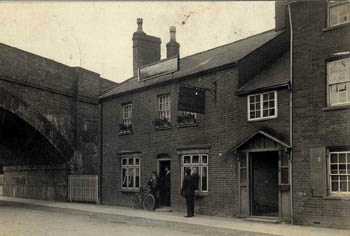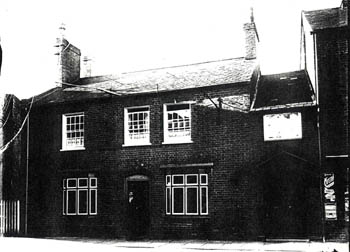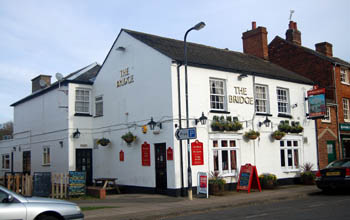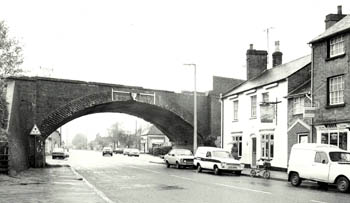The Bridge Public House Shefford

Railway Inn about 1920 [Z1306/101]
Bridge Public House: 50 High Street, Shefford
The Bridge is named after the railway bridge which used to stand at the left hand side of the public house's frontage until 1976 when it was demolished. The public house began its life as the Railway Inn, later the Railway Hotel, being renamed in 1962 when the railway, and Shefford Station, closed.
The property was built by John Ibbs. He had purchased a cottage on the site in 1843 from the executors of Joseph Ibbs [WL1000/1/SHE/1/3]. By 1848, when he used the property as security for a further advance [WL1000/1/SHE/1/5] that cottage had been demolished as the deed makes clear: "site of a cottage and shop and garden totalling 20 poles on the north side of Ampthill Street, Shefford late in occupation of Thomas Haynes…and a dwellinghouse and brewhouse built by John Ibbs on the said land, occupied by him, then Sarah Ibbs, now Charles King and known as the Railway Inn with all coppers, furnaces, vats, tuns, coolers, back fixtures etc.".
In 1872 Ibbs conveyed the inn to its tenant, Charles King [WL1000/1/SHE/1/9] who then mortgaged it to Caroline Cook [WL1000/1/SHE/1/10]. In 1875 King took out another mortgage with John King [WL1000/1/SHE/1/11]. This deed shows that the public house brewed its own beer and gives a detailed inventory of both brewery and house:
- Brewery: 1 copper with tap; 1 mash tun and sponger; 1 cooler; 1 under back; 1 wood and lead tank; 1 copper pump; 1 lift pump; 1 working square; 2 working troughs; 4 working tubs; 6 tubs; 10 pails and yoke; 12 drink stalls; 6 sparge tins; 1 filling up tin with copper spout; 1 finning up tin; 2 vats; 4 hogsheads; 4 large barrels; 29 ale pipes; 200 casks various sizes;
- Orchard, stable loft etc.: 1 horse; 2 carts; 2 sets of harnesses; bean and oat mill; chaff cutter; 14 corn bins; 1 bobbys udder; 1 malt mill; dog, kennel, collar and chain; 3 pig troughs; 21 pigs; hog dung in the styes and yard; quantity of faggots, firewood, hay, corn and straw; 3 forms; 1 truck; 2 wheel barrows; quantity of oak and other timbers; 3 ladders; quantity of boards, bungs, corks and chires; grindstone; frame, hammers, augers, screwdrivers, hammer, branding irons and figures; weights and scales; 4 posts and sockets; lot of oak spokes; 3 makers, rules; 1 rake; quantity of piping; 3 troughs and spouts; 12 mops and brushes;
- Front living room: 3 tables; 1 sofa; 14 chairs; hearth rugs; 2 carpets; chimney glass; glass ornaments; 30 boxes cigars; dog; 1 case; 1 gun and case; 8 pictures; 6 dozen wine; gas burners; 1 lamp; fender guard and fire irons; window curtains and blinds;
- Tap room: 2 tables; gas burner, lamp and fender; 5 pictures; window curtains and blind;
- Bar parlour: 2 tables, 1 cushioned seat; 7 chairs; chimney glass; fire irons, fender and ornaments; rug and mat; 1 case of stuffed birds; 6 pictures; gas burner and lamp; window curtains and blind;
- Bar: beer engine and sink; clock; quantity of glasses; pewter measures; earthenware pots; earthenware jugs; 3 glass spirit jars and taps; 5 stone jars and taps; 12 taps; a quantity of preserves in pots; tins; biscuits and other small articles;
- Kitchen: pimp and sink; chopping block; 2 tables; 3 dozen knives and forks; 4 shoe brushes; 6 dozen plates and dishes; 1 copper; 18 hams and cheeks; 1 plate sack; 100 foot lot of shelving; 3 kettles; boiler and 8 saucepans; 8 beer tins; washing rack and screen and safe; fender and fire irons and sundry kitchen utensils; 2 pork pots; 4 ham pans;
- In the yard: 12 wooden beer bottles; bottle sack; quarter butts; old tun and old squares; 2 barrel slides; 4 washing trays; 2 stands and 3 ropes;
- Front room No.1: 1 bedstead; 2 feather beds' mattresses; 3 blankets; 1 counterpane; bed furniture; 2 pillows and bolster; 7 chairs; 1 swing glass dressing table; set of drawers; wash stand and furniture; night commode; writing desk; 6 boxes; 4 decanters; 4 glasses; 2 glass globes; towel horse; 1 sampler; lot of ornaments; carpet and 2 wool mats; window curtains; 3 large cushions; landing floor cloth; 5 mats; 1 table; 2 boxes; 3 wicker flats; 2 boxes;
- Back room: 1 oak coffer; 4 spirit jars; 3 wood jars; 1 bath; 3 clothes horses; 1 basket and bag; 1 iron; crib; shoe stand; 2 chairs; coal scuttle; sea kettle; carpets and matting; 3 clothes baskets; 1 iron press;
- Staircase: floorcloth and rods;
- Room no.3: iron bedstead; 1 feather bed, bolster and 2 pillows; 2 mattresses; 5 sheets, blankets and quilt; 1 book case and books; 2 looking glasses; bed slips; 7 chairs; 1 chest of drawers; 1 double set of drawers; 12 pairs of sheets; 12 table cloths; stand and books; 4 pictures; set of tea trays; wash hand stand; 2 tables; water can; solid leather portmanteau; 2 cases of stuffed birds; window pole and curtains; 2 boxes; 2 fenders; set of fire irons and guard; chess box and men; quantity of ornaments; carpet and rug;
- Small room: 1 bedstead; 1 feather bed; 2 mattresses; bolster and pillows; blankets; 2 sheets; 2 pictures; 1 case of birds; 1 looking glass; dressing table; 1 washing stand; 1 chiffonier; blinds and curtains; 2 chairs; 2 boxes; lot of ornaments; 1 tea service;
- Back room: 1 bedstead; 1 crib; 2 beds; 3 mattresses; 5 blankets; 2 counterpanes; 1 chest of drawers; 1 table; 1 wash stand; 1 chair; 2 boxes; 6 window poles and rings; window curtains; 1 foot bath; carpet; looking glass

Railway about 1920 [WL800/4]
Charles King died in 1879, this notice was printed in the Bedfordshire Mercury of 30th August: "Shefford: Sudden Death: On Friday August 22nd, a man named King, a publican and brewer in this town, died very suddenly. He had been to the market and on his return home he fell down in the house and instantly expired. It was not thought necessary to hold an inquest as the man had been in bad health for some time, and had been attended by Mr Balding".
Elizabeth King, Charles King's widow took over the property and ran it for another seven years. In 1884 Caroline Cook also assigned her mortgage to John King [WL1000/1/SHE/1/13]. At some point, perhaps in 1886 when she gave up being the licensee, Elizabeth King sold the public house and licensing registers reveal that the new owner was John King. He later sold the business to Bedford brewer Charles Wells who were the owners in 1927 when the town of Shefford was valued under the Rating Valuation Act 1925; every piece of land and building on the country was assessed to determine the rates to be paid on it. The valuer at the Railway Inn noted [DV1/C290/80-81] that the building was constructed of brick and slate and comprised: a tap room ["good"]; saloon ["fair"]; billiard room ["Full size table"] measuring 18 feet by 30½ feet; a private living room; kitchen; 6 bedrooms upstairs with box room. Outside were a brick and corrugated iron large garage 20 feet by 30 feet, four wood and felt pigsties, a brick and corrugated iron hovel and a large barn for pigs with a loft over. There were also 4.558 acres in three adjoining fields. Weekly trade was 1½ barrels and 10-12 dozen bottles of beer, and half a gallon spirits.
At the time of writing [2008] the Bridge remains a Charles Wells public house.

Bridge public house January 2008
Document References:
- WL1000/1/SHEF/1/3: conveyance of cottage and shop on north side of Ampthill Road from executors of Joseph Ibbs to John Ibbs: 1843;
- WL1000/1/SHEF/1/5: further charge secured on newly built cottage and brewhouse: 1848;
- WL1000/1/SHEF/1/9: conveyance of Railway Inn from Joseph Ibbs to Charles King: 1872;
- WL1000/1/Shefford/1/10: mortgage from Charles King to Caroline Cook: 1872;
- HF143/1: Register of Alehouse Licences - Biggleswade Petty Sessional Division: 1872-1873;
- HF143/2: Register of Alehouse Licences - Biggleswade Petty Sessional Division: 1874-1877;
- WL1000/1/SHEF/1/11: mortgage from Charles King to John King: 1875;
- HF143/3: Register of Alehouse Licences - Biggleswade Petty Sessional Division: 1878-1881;
- HF143/4: Register of Alehouse Licences - Biggleswade Petty Sessional Division: 1882-1890;
- WL1000/1/SHEF/1/13: transfer of mortgage from Caroline Cook to John King: 1884;
- HF143/5: Register of Alehouse Licences - Biggleswade Petty Sessional Division: 1891-1900;
- GK164/18: scheduled lease from Dewsnap and King to Holden and Bond Smith: 1894;
- GK1/36: Bound Sale Catalogue of Baldock Brewery Limited: 1898;
- GK164/18: assignment to share Bond Smith to Holden: 1900;
- HF143/6: Register of Alehouse Licences - Biggleswade Petty Sessional Division: 1900-1914;
- PSBW8/1: Register of Alehouse Licences - Biggleswade Petty Sessional Division: 1903-1915;
- WL800/4: photograph: c.1925;
- WL801/131: glass plate negative: c.1925
- PSBW8/3: Register of Alehouse Licences - Biggleswade and North Bedfordshire Petty Sessional Divisions: 1976-1980.

Bridge in 1976 [Z50/101/18]
List of Licensees:
Note that this is not a complete list; entries in italics refer to licensees where either beginning or end, or both, dates are not known:
1843: John Ibbs;
Sarah Ibbs;
1848-1879: Charles King (and brewer);
1879-1886: Elizabeth King;
1886-1888: Henry Edwards;
1888-1893: Francis Gray;
1893-1894: John Payne;
1894: Ferdinand George Francis King;
1894-1896: Thomas Russell;
1896-1897: Walter Lucas;
1897-1899: William Thomas Davey;
1899-1901: Joseph Swanger;
1901-1903: Arthur Bancroft Stewart;
1903: Ernest Philip Sanders;
1903-1905: John Rook;
1905-1906: Harry Eustace;
1906-1907: Charles Dunham [convicted on 18 Jul 1906 for permitting drunkenness - fined £2 with 7/6 costs];
1907-1909: John George Steele;
1909-1913: Frederick Murray Thorne;
1913-1914: Charles Odell;
1914: John Musson Haines;
1920: William Longley;
1928: William Clarke;
1931-1972: George Charles Hayes;
1972-1987: Albert Smyth;
1987-1995: Keith Pakes;
1996-2008: Malcolm & Ann McClean;
2008-2010: Stuart & Rachel Jeffrey;
2010: Steve Wilkinson (temporary manager);
2010-2011: Mark Beal